Figures & data
Fig. 1 Study Design. Legend: The figure above outlines the study design for the 10-week cohort. Note, that the second (6-week) cohort followed the same experimental procedures with the exception of training duration, which lasted only 6 weeks (or 12 total workouts)
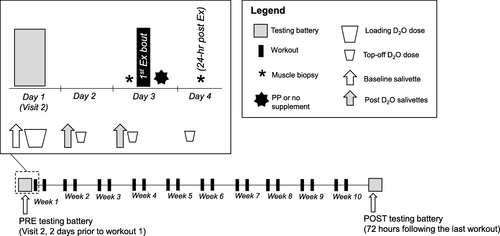
Table 1 Amino acid content in PP per serving
Fig. 2 Myofibrillar protein synthesis rates following the first bout of training with or without PP supplementation. Legend: No differences between conditions existed for the leg extensor (panel a) or leg press (panel b) training volume during the first training bout. Saliva D2O enrichment increased from baseline V2 to V3 and V4 regardless of supplementation (panel c). Myofibrillar protein synthesis rates 24 h following the first exercise bout did not differ between PP and CTL participants (panel d). All data are presented as mean ± standard deviation values. Abbreviations: PP, peanut powder supplemented participants; CTL, non-supplemented participants
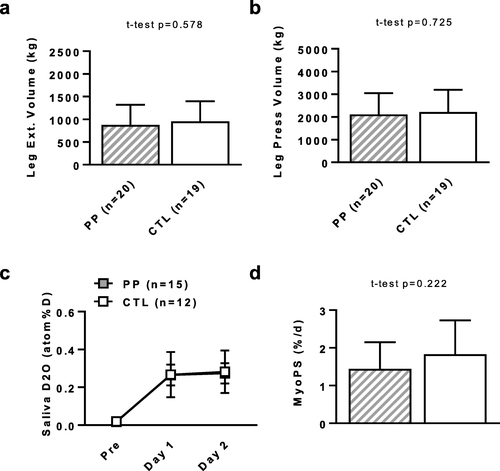
Fig. 3 CONSORT Diagram. Legend: The diagram indicates how many individuals were screened and completed the intervention

Table 2 Baseline Participant Characteristics
Table 3 Pre- and post-intervention food recall data
Fig. 4 Differences in Exercise Volumes over the Duration of Training. Legend: Data in this figure indicate that bench press volume (panel a), lat pulldown volume (panel b), leg press volume (panel c), leg extension volume (panel d), and leg curl volume (panel e) did not differ between supplementation groups in the 6-week, 10-week or pooled cohorts. All data are presented as mean ± standard deviation values. Abbreviations: PP, peanut powder supplemented participants; CTL, non-supplemented participants

Fig. 5 Changes in DXA Fat Mass, LSTM and Percent Body Fat. Legend: Data in this figure indicate that changes in DXA-derived fat mass (panel a), DXA-derived lean soft tissue mass (panel b), or DXA-derived percent body fat (panel c) did not differ between supplementation groups. All data are presented as mean ± standard deviation values. Abbreviations: PP, peanut powder supplemented participants; CTL, non-supplemented participants

Fig. 6 Changes in Mid-thigh Muscle Hypertrophy Measurements. Legend: Data in this figure indicate that vastus lateralis (VL) muscle thickness increased in PP participants when the 6- and 10-week cohorts were pooled, whereas this did not occur in CTL participants (panel a). However, a significant interaction was not observed in pQCT-derived mid-thigh lean muscle cross sectional area values (panel b) or mid-thigh pQCT-derived muscle density (panel c). All data are presented as mean ± standard deviation values. Abbreviations: PP, peanut powder supplemented participants; CTL, non-supplemented participants. Symbols: *, significant increase within PP from Pre to Post (p < 0.05); #, PP < CTL at Pre (p < 0.05)
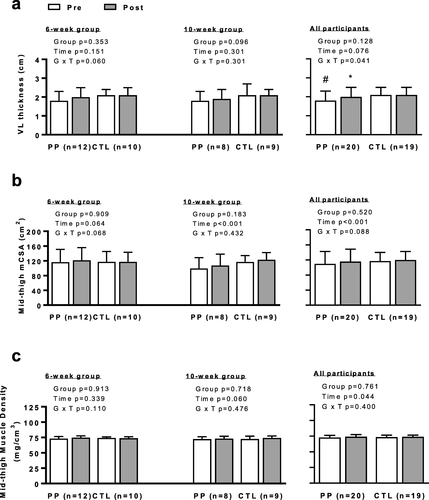
Fig. 7 Right Leg Knee Extensor and Flexion Peak Torque. Legend: Data in this figure indicate that knee extensor peak torque increased with training, regardless of supplementation (panel a). The same was observed with knee flexion peak torque (panel b); however, PP supplementation increased this metric in the 10-week cohort, whereas this metric did not increase in CTL participants. All data are presented as mean ± standard deviation values. Abbreviations: PP, peanut powder supplemented participants; CTL, non-supplemented participants. Symbols: *, significant increase within PP from Pre to Post (p < 0.05)
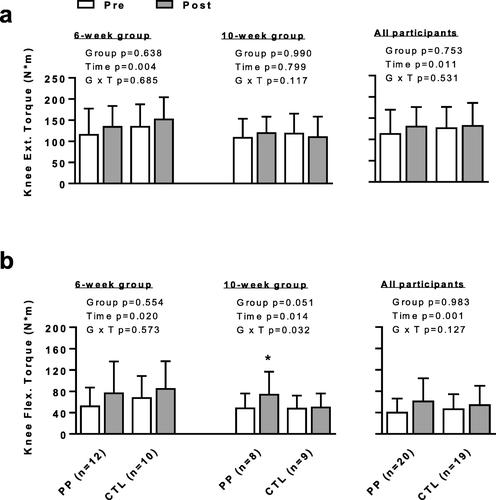
Fig. 8 Select correlations between age and key dependent variables in each supplement group. Legend: These data show correlations between age and change in DXA LSTM (panel a), change in pQCT muscle density (panel b), and change in pQCT mCSA (panel c). Abbreviations: PP, peanut powder supplemented participants; CTL, non-supplemented participants
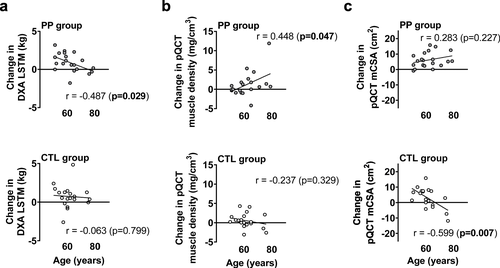
Availability of data and materials
All raw data can be obtained by emailing the corresponding author ([email protected]).
